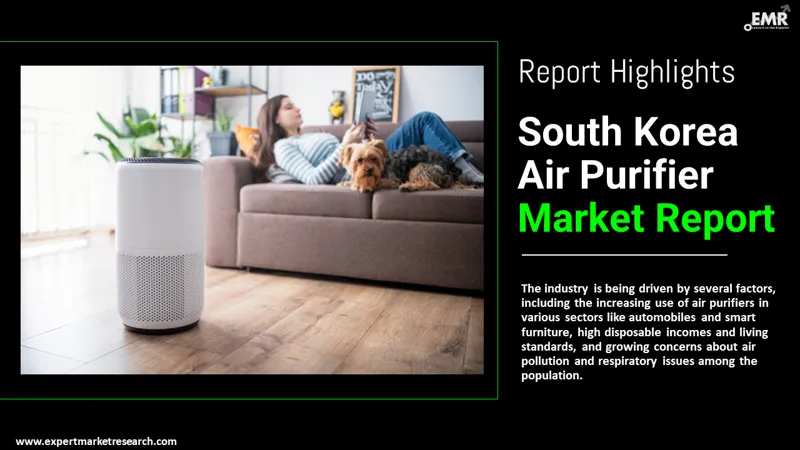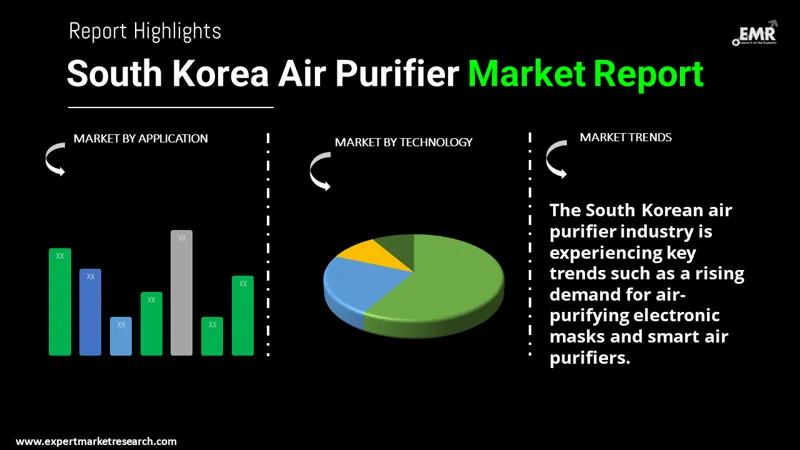
Consumer Insights
Uncover trends and behaviors shaping consumer choices today
Procurement Insights
Optimize your sourcing strategy with key market data
Industry Stats
Stay ahead with the latest trends and market analysis.
The South Korea air purifier market is expected to grow at a CAGR of 10.00% between 2026 and 2035. The market is majorly driven by yellow dust, fine dust and increasing airborne diseases leading to the expansion of the air purifier market in South Korea.
Base Year
Historical Period
Forecast Period
Compound Annual Growth Rate
10%
2026-2035
*this image is indicative*
A system known as an air purifier may be put in buildings such as homes, offices, and other public spaces to purify the air by removing pollutants and only leaving oxygen behind. Air purifiers are used to rid the air of any dangerous gases, dust, or pollution in general, as implied by their name. There are several different categories into which air purifiers may be divided, including smart and portable models.
Samsung Electronics introduced the Bespoke Cube Air, a cube-shaped air purifier, in December 2020. The air purifier has a photocatalytic UV sterilisation feature that kills germs and viruses in the air. The air purifier can eliminate more than 99 per cent of harmful bacteria, including yellow staphylococcus, bacteriophages, and coliforms, when germs are introduced into the filter. Due to a WLAN device within, the Cube Air may be operated via a mobile app. LG Electronics plans to launch its wearable air-purifying electronic mask, known as the LG PuriCare, in South Korea. The face mask from LG Electronics is already available in the Philippines, Indonesia, Hong Kong, and Thailand. Due to problems with the regulatory board, it was not launched in South Korea.

Read more about this report - REQUEST FREE SAMPLE COPY IN PDF
LG Electronics Launched the PuriCare Object Collection Aero Furniture, a customisable table-type air purifier. The product is compact in size and can fit in small areas such as a studio, study room, or any small room. The product has several features indicating air quality, airflow, smartphones and earbuds charging, and Wi-Fi connectivity, among others. Moreover, the components of the air purifier are made with reusable plastics taken from old appliances. The company also plans to collaborate with artist Kim Sun-woo to launch more aesthetically appealing versions of the product.
Hyundai Mobis, the parts-making division of the Hyundai Motor Group in South Korea, has created a technique to sterilise and purify vehicles' indoor air instead of filtering pollutants through automobile air conditioner filters or utilising a separate air purifier indoors in response to a new trend that prioritises cleanliness owing to the COVID-19 epidemic. In order to eliminate floating germs from mechanical equipment, Hyundai Mobis has created an integrated air sterilisation system that uses ultraviolet (UV) radiation. and an antibacterial material-based air duct technology. When a UV light-emitting diode (LED) is exposed to a photocatalytic filter, hydroxyl radicals are produced that are used in UV photocatalytic sterilisation. Virus surface features are oxidised by these hydroxyl radicals, which also damage vital bacterial cell components.
In order to prevent a variety of health issues, clean air is crucial for well-being. As people's concerns about fine particles grow, demand is soaring. Each year, South Korea, especially in the spring, struggles with fine dust and yellow dust, which is one of the key factors that contribute to respiratory ailments. Typically, China is the source of yellow dust. The other factors driving the South Korea air purifier market growth are the growing incidence of airborne illnesses and the rising levels of pollution in metropolitan areas. Additionally, greater health consciousness, rising disposable income, and a higher standard of life are the other major drivers anticipated to fuel the industry's expansion.
Ammonia, methyl chloride, sulphur dioxide, and chlorofluorocarbons are linked to indoor air purifiers. This is another source of concern for global warming and the ozone layer. All of the particles that pass through a filter are destroyed by UV radiation. To maximise the efficiency of air purification, UV technology is frequently used in conjunction with air filters. The fact that the UV-treated filter also tends to split water and oxygen molecules into hydroxyl and ozone is equally astounding to humans. The components that break down then interact with other contaminants and pose more hazards to health. Therefore, UV air purifiers might not be a good option for particle matter. This factor could pose a hindrance to the air purifier market growth due to the growing environmental awareness among consumers.

Read more about this report - REQUEST FREE SAMPLE COPY IN PDF
The EMR’s report titled “South Korea Air Purifier Market Report and Forecast 2026-2035" offers a detailed analysis of the market based on the following segments:
Market Breakup by Technology
Market Breakup by Application
Due to the rising respiratory issues and allergies among the South Korean population due to fine dust and yellow dust, along with the growing incidences of airborne diseases worldwide, HEPA technology is the most efficient and advanced in the market and is expected to dominate the market during the mentioned forecast period. Even though HEPA filters have a significant market share due to their capability to capture pollen, fine dust, smoke, and other suspended fine particles, other filters such as activated carbon, and ionic filters are used along with HEPA technology in air purifiers. With the growing concerns about air pollution, the air purifier industry is expected to experience a significant boost.
Household air purifiers are used to clean the air inside their homes. The use of air purifiers in home settings has increased due to the growing knowledge of the dangers posed by volatile organic compounds (VOCs), smoking particles, and other particulate matter to human health. Furthermore, the lockdown measures implemented worldwide to minimise the spread of COVID-19 have resulted in individuals working from home and staying indoors. This factor has led to the proliferation of air purifiers in the residential sector. Printing, petrochemicals, power generation, chemicals, food and beverage, and manufacturing are just a few of the industries that use air purifiers. When left untreated, dangerous particles like welding smoke, asbestos, construction dust, and other irritants can injure workers and have a negative effect on the environment. Air purifiers assist in removing these particles.
The comprehensive EMR report provides an in-depth assessment of the market based on the Porter's five forces model along with giving a SWOT analysis. The report gives a detailed analysis of the following key players in the South Korea air purifier market, covering their competitive landscape and latest developments like mergers, acquisitions, investments and expansion plans.
Coway Co Ltd (Coway) designs, produces and markets purifiers. The firm sells a variety of household appliances, bidets, water softeners, air purifiers, and water filtration systems. Sterilization and cleaning are among the care services the business provides. Coway offers a range of services, including those for self-management, care specialists, environmental analysis, and water quality testing. Coway also manufactures oriental herbal cosmetic products and functional cosmetics. The corporation has operations in North America, Asia Pacific, and Europe. Seoul, South Korea serves as the headquarters of Coway.
South Korean home appliance manufacturer Winia Electronics, formerly known as Daewoo Electronics, is a part of the Winia Group. It was founded in 1971 and has since developed into a multinational corporation with more than 64 production facilities, research and development facilities, and sales centres spread across more than 40 nations. DESUK, or Daewoo Electronics Sales UK, was founded in November 1993. It is the third-largest electronics company in South Korea after Samsung and LG. The headquarter of Winia Electronics is situated in Seoul, South Korea.
*Please note that this is only a partial list; the complete list of key players is available in the full report. Additionally, the list of key players can be customized to better suit your needs.*
Other key players in South Korea Air Purifier Market are IQAir AG, LG Electronics, Blueair, Koninklijke Philips N.V., Samsung Electronics Co., Ltd., Dyson Limited, Cuckoo Holdings Co., Ltd. and Xiaomi Corporation among others.




*While we strive to always give you current and accurate information, the numbers depicted on the website are indicative and may differ from the actual numbers in the main report. At Expert Market Research, we aim to bring you the latest insights and trends in the market. Using our analyses and forecasts, stakeholders can understand the market dynamics, navigate challenges, and capitalize on opportunities to make data-driven strategic decisions.*
Get in touch with us for a customized solution tailored to your unique requirements and save upto 35%!
The market is projected to grow at a CAGR of 10.00% between 2026 and 2035.
The surge in air purifier usage in various industries, such as automobiles and smart furniture, along with high disposable income, high living standards, and growing air pollution and respiratory issues among people, are the major industry drivers.
The demand for air-purifying electronic masks and smart air purifiers are the key trends of South Korea air purifier industry.
The major players in South Korea air purifier industry are IQAir AG, LG Electronics, Blueair, Koninklijke Philips N.V., Samsung Electronics Co., Ltd., Coway, Dyson Limited, WINIA Electronics Co., Ltd, Cuckoo Holdings Co., Ltd., and Xiaomi Corporation, among others.
Explore our key highlights of the report and gain a concise overview of key findings, trends, and actionable insights that will empower your strategic decisions.
| REPORT FEATURES | DETAILS |
| Base Year | 2025 |
| Historical Period | 2019-2025 |
| Forecast Period | 2026-2035 |
| Scope of the Report |
Historical and Forecast Trends, Industry Drivers and Constraints, Historical and Forecast Market Analysis by Segment:
|
| Breakup by Technology |
|
| Breakup by Application |
|
| Market Dynamics |
|
| Competitive Landscape |
|
| Companies Covered |
|
Single User License
One User
USD 3,999
USD 3,599
tax inclusive*
Datasheet
One User
USD 2,499
USD 2,249
tax inclusive*
Five User License
Five User
USD 4,999
USD 4,249
tax inclusive*
Corporate License
Unlimited Users
USD 5,999
USD 5,099
tax inclusive*
*Please note that the prices mentioned below are starting prices for each bundle type. Kindly contact our team for further details.*
Flash Bundle
Small Business Bundle
Growth Bundle
Enterprise Bundle
*Please note that the prices mentioned below are starting prices for each bundle type. Kindly contact our team for further details.*
Flash Bundle
Number of Reports: 3
20%
tax inclusive*
Small Business Bundle
Number of Reports: 5
25%
tax inclusive*
Growth Bundle
Number of Reports: 8
30%
tax inclusive*
Enterprise Bundle
Number of Reports: 10
35%
tax inclusive*
How To Order

Select License Type
Choose the right license for your needs and access rights.

Click on ‘Buy Now’
Add the report to your cart with one click and proceed to register.

Select Mode of Payment
Choose a payment option for a secure checkout. You will be redirected accordingly.
Gain insights to stay ahead and seize opportunities.

Get insights & trends for a competitive edge.

Track prices with detailed trend reports.

Analyse trade data for supply chain insights.

Leverage cost reports for smart savings

Enhance supply chain with partnerships.

Connect For More Information
Our expert team of analysts will offer full support and resolve any queries regarding the report, before and after the purchase.
Our expert team of analysts will offer full support and resolve any queries regarding the report, before and after the purchase.
We employ meticulous research methods, blending advanced analytics and expert insights to deliver accurate, actionable industry intelligence, staying ahead of competitors.
Our skilled analysts offer unparalleled competitive advantage with detailed insights on current and emerging markets, ensuring your strategic edge.
We offer an in-depth yet simplified presentation of industry insights and analysis to meet your specific requirements effectively.
Share